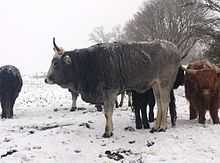Podolica
 A Podolica cow in winter | |
| Conservation status | stable |
|---|---|
| Country of origin | Italy |
| Distribution | |
| Standard | ANABIC |
| Use | Triple-purpose: draught, beef, milk |
| Traits | |
| Weight | Male: 800 kg[1] |
| Female: 650 kg[1] | |
| Height | Male: 150 cm[1] |
| Female: 145 cm[1] | |
| Skin color | black |
| Coat | Grey, black switch |
| Horn status | Horned |
|
Cattle Bos primigenius | |
The Podolica is a breed of domestic cattle from southern Italy.[2] It belongs to the Podolic group of grey cattle. It is raised in the regions of Abruzzo, Basilicata, Calabria, Campania, Molise and Puglia.[3] It was formerly distributed throughout most of mainland Italy and as far as Istria,[4] now part of Croatia, and where it is now regarded as a separate breed, Istrian cattle.[5] The Podolica was in the past bred principally as a draught animal; with the mechanisation of agriculture following the Second World War demand for draught oxen disappeared, and the Podolica is now raised for meat and, to a lesser extent, for milk.[4]
History
The origins of the Podolica breed are not known. As with other European grey cattle, it has been suggested that it derives from cattle of the Podolian steppes of eastern Europe, possibly brought to Italy by invading Goths in the fifth century AD or by the Lombard king Agilulf in the sixth century.[4] This hypothesis is based on the zoological theories of the nineteenth century, going back to the Bos taurus podolicus of Johann Andreas Wagner. It is not supported by modern genetic, zoological or archaeological research.[6]
There were numerous regional and other types of Italian grey cattle: the Abruzzese, the Calabrese, the Montanara, the Murgese, the Pugliese, the Pugliese del Basso Veneto and others.[4][7] The name "Podolico" for grey cattle came into use in Italy from the early 20th century.The need for a herdbook was recognised in 1976; it was established in 1984, and a breed standard drawn up from observation of about 15,000 animals.[6] In 1986 the standards of selection were modified to allow meat production to be favoured over other characteristics.[8]
The total population was estimated in 2008 at 100,000 head, of which about 25,000 were recorded in the herdbook.[4] At the end of 2013 the total number registered in the herdbook was 27,509, including 391 registered bulls; more than 80% of the registered stock was in Basilicata and Campania.[3]
The breed is considered to be at risk from indiscriminate cross-breeding with bulls of specialised meat breeds.[4]
Characteristics
The Podolica is a rustic breed capable of surviving on harsh terrain and poor pasture. It can exploit food sources that would not otherwise be used, including stubble, scrub and maquis, and woodland undergrowth. The animals are fed hay and straw only in winter.[4]
The colour of the Podolica shows pronounced sexual dimorphism: cows are pale grey, tending to white, while males are darker and may be almost black. As in other breeds of grey cattle, the calves are born wheat-coloured but become grey at about three months.[4] The skin is black, as are the natural openings. The horns are light, lyre-shaped in cows, half-moon-shaped in bulls; they are slate-grey in young animals, becoming pale at the base and dark at the tip with maturity.The breed is of medium size and lightweight; the skeleton is light.[4] The average height at the withers is 145 cm in females, and 150 cm in males; average weight for cows is 650 kg, and 800 kg for bulls.[1]
Use
The Podolica was in the past mainly kept for draught work; meat and milk production were secondary to this. After the Second World War the progressive mechanisation of agriculture meant that demand for draught oxen disappeared. The breed is now raised mainly for meat; in some areas it is also kept for milk.
Calves are weaned no sooner than four months; they are normally sent to slaughter at 15–16 months, at which time they weigh 300–350 kg. The meat is considered to be of high quality and carries a registered mark of quality.[4]
The average milk yield is low; a figure of 1,500 kg was cited in the 1950s. The milk is used to make caciocavallo; the sought-after Caciocavallo Podolico del Gargano is made only from it.[4]
See also
References
- ↑ 1.0 1.1 1.2 1.3 1.4 Breed data sheet: Podolica/Italy. Domestic Animal Diversity Information System of the Food and Agriculture Organization of the United Nations. Accessed May 2014.
- ↑ B. Moioli, F. Napolitano and G. Catillo (2004). Genetic Diversity between Piedmontese, Maremmana, and Podolica Cattle Breeds. Journal of Heredity 95 (3): 250-256. doi: 10.1093/jhered/esh032.
- ↑ 3.0 3.1 Consistenze al 31.12.2013 (in Italian). Associazione Nazionale Allevatori Bovini Italiani da Carne (ANABIC). Accessed May 2014.
- ↑ 4.0 4.1 4.2 4.3 4.4 4.5 4.6 4.7 4.8 4.9 4.10 Daniele Bigi, Alessio Zanon (2008). Atlante delle razze autoctone: Bovini, equini, ovicaprini, suini allevati in Italia (in Italian). Milan: Edagricole. ISBN 9788850652594. p. 58–60.
- ↑ Breed data sheet: Istrian/Croatia. Domestic Animal Diversity Information System of the Food and Agriculture Organization of the United Nations. Accessed May 2014.
- ↑ 6.0 6.1 Donato Matassino (2011). Filosofia strategica gestionale di un bioterritorio allevante il "Bovino Grigio Autoctono Italiano (BovGRAI)" (già "Podolica") (in Italian). Conference paper, Convegno "Dal pascolo alla tavola: sicurezza e qualità dei prodotti podolici", Zungoli (AV), 29 October 2011. Accessed May 2014.
- ↑ Imre Bodó, István Gera, Gábor Koppány, trans. Béla Borsos (2004). The Hungarian Grey Cattle Breed. Budapest: Magyar Szürke Szarvasmarhát Tenyésztôk Egyesülete.
- ↑ Standards di razza: Podolica (in Italian). Associazione Nazionale Allevatori Bovini Italiani da Carne (ANABIC). Accessed May 2014.
| ||||||||||||||||||||